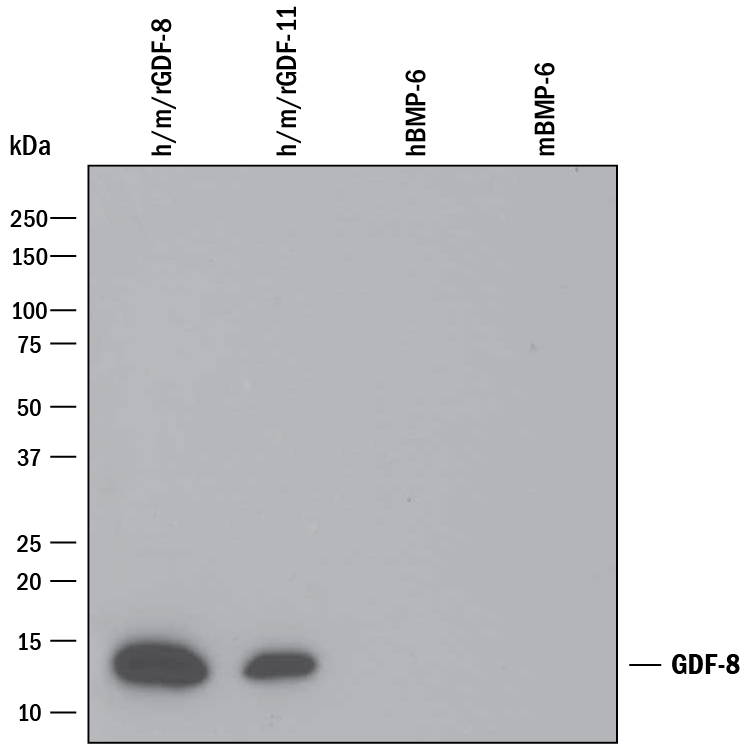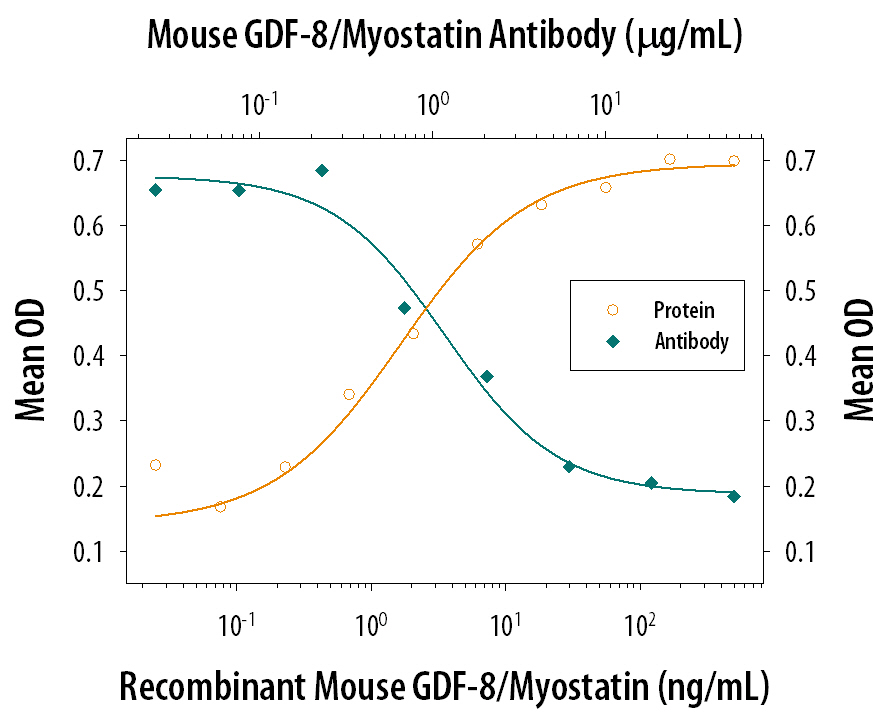Human/Mouse/Rat GDF-8/Myostatin Antibody Summary
Applications
Please Note: Optimal dilutions should be determined by each laboratory for each application. General Protocols are available in the Technical Information section on our website.
Scientific Data
 View Larger
View Larger
Detection of Recombinant Human, Mouse, and Rat GDF-8/Myostatin by Western Blot. Western blot shows 25 ng of Recombinant Human/Mouse/Rat GDF-8/Myostatin (788-G8), Recombinant Human/Mouse/Rat GDF-11/BMP-11 (Catalog # 1958-GD), Recombinant Human BMP-6 (507-BP), and Recombinant Mouse BMP-6 (Catalog # 6325-BM). PVDF Membrane was probed with 0.1 µg/mL of Goat Anti-Human/Mouse/Rat GDF-8/Myostatin Antigen Affinity-purified Polyclonal Antibody (Catalog # AF788) followed by HRP-conjugated Anti-Goat IgG Secondary Antibody (Catalog # HAF109). A specific band was detected for GDF-8/Myostatin at approximately 14 kDa (as indicated). This experiment was conducted under reducing conditions and using Immunoblot Buffer Group 3.
 View Larger
View Larger
GDF‑8/Myostatin in Mouse Embryo. GDF-8/Myostatin was detected in immersion fixed frozen sections of mouse embryo (10 d.p.c., section through neural tube) using Goat Anti-Human/Mouse/Rat GDF-8/Myostatin Antigen Affinity-purified Polyclonal Antibody (Catalog # AF788) at 15 µg/mL overnight at 4 °C. Tissue was stained using the Anti-Goat HRP-DAB Cell & Tissue Staining Kit (brown; CTS008) and counterstained with hematoxylin (blue). View our protocol for Chromogenic IHC Staining of Frozen Tissue Sections.
 View Larger
View Larger
Hemoglobin Expression Induced by GDF‑8/Myostatin and Neutralization by Mouse GDF‑8/Myostatin Antibody. Recombinant Mouse GDF-8/Myostatin (Catalog # 788-G8) increases hemoglobin expression in the K562 human chronic myelogenous leukemia cell line in a dose-dependent manner (orange line), as measured by the psuedoperoxidase assay. Hemoglobin expression elicited by Recombinant Mouse GDF-8/Myostatin (30 ng/mL) is neutralized (green line) by increasing concentrations of Goat Anti-Human/Mouse/Rat GDF-8/Myostatin Antigen Affinity-purified Polyclonal Antibody (Catalog # AF788). The ND50 is typically 0.6-3 µg/mL.
Reconstitution Calculator
Preparation and Storage
- 12 months from date of receipt, -20 to -70 degreesC as supplied. 1 month, 2 to 8 degreesC under sterile conditions after reconstitution. 6 months, -20 to -70 degreesC under sterile conditions after reconstitution.
Background: GDF-8/Myostatin
Growth Differentiation Factor 8 (GDF-8), also known as myostatin, is a member of the TGF-beta superfamily that is expressed specifically in developing and adult skeletal muscle. GDF-8 cDNA encodes a 376 amino acid (aa) prepropeptide with a 24 aa residue signal peptide, a 223 aa residue amino-terminal propeptide, and a 109 aa residue carboxy-terminal mature protein. Mature GDF-8 contains the canonical 7-cysteine motif common to other TGF-beta superfamily members. Similar to the TGF-beta s, activins and BMP-11, GDF-8 also contains one extra pair of cysteine residues that is not found in other family members. The bioactive form of GDF-8 is a homodimer with an apparent molecular weight of approximately 25 kDa. GDF-8 is highly conserved across species. At the amino acid sequence level, mature human, mouse, rat and cow GDF-8 are 100% identical. Within the TGF-beta superfamily, GDF-8 is most closely related to BMP-11, a mammalian protein that acts as a dorsal mesoderm and neural inducer in Xenopus explants. The two proteins share 90% amino acid sequence identity within their mature chain. A targeted disruption of GDF-8 in mouse results in large mice with a widespread increase in skeletal muscle mass, indicating that GDF-8 is a negative regulator of skeletal muscle growth. A mutation in the bovine GDF-8 gene has been shown to be responsible for the double-muscled phenotype in cattle breeds such as Belgian Blue cattle that is characterized by an increase in muscle mass. GDF-8 has also been shown to inhibit preadipocyte differentiation to adipocytes. Mature GDF-8 binds to activin type II receptors and the binding is antagonized by the activin-binding protein, follistatin. R&D Systems recombinant GDF-8 preparations have been shown to act similarly to Activin A in both the Xenopus animal cap and the K562 assays.
- Storm, E.E. et al. (1994) Nature 368:639.
- Sharma, M. et al. (1999) J. Cell Physiol. 180:1.
- McPherron, A.C. et al. (1997) Nature 387:83.
- Lee, S.J. et al. (2001) Proc. Natl. Acad. Sci. USA 98:9306.
- Kim, H.S. et al. (2001) Biochem. Biophys. Res. Commun. 281:902.
Product Datasheets
Citations for Human/Mouse/Rat GDF-8/Myostatin Antibody
R&D Systems personnel manually curate a database that contains references using R&D Systems products. The data collected includes not only links to publications in PubMed, but also provides information about sample types, species, and experimental conditions.
11
Citations: Showing 1 - 10
Filter your results:
Filter by:
-
The relationship between myodural bridges, hyperplasia of the suboccipital musculature, and intracranial pressure
Authors: C Li, C Yue, ZC Liu, J Gong, XS Wei, H Yang, C Gilmore, SB Yu, GD Hack, HJ Sui
PLoS ONE, 2022-09-02;17(9):e0273193.
Species: Rat
Sample Types: Tissue Homogenates
Applications: Western Blot -
Novel myostatin-specific antibody enhances muscle strength in muscle disease models
Authors: H Muramatsu, T Kuramochi, H Katada, A Ueyama, Y Ruike, K Ohmine, M Shida-Kawa, R Miyano-Nis, Y Shimizu, M Okuda, Y Hori, M Hayashi, K Haraya, N Ban, T Nonaka, M Honda, H Kitamura, K Hattori, T Kitazawa, T Igawa, Y Kawabe, J Nezu
Scientific Reports, 2021-01-25;11(1):2160.
Species: Mouse
Sample Types: Tissue Homogenates
Applications: Western Blot -
A GDF11/myostatin inhibitor, GDF11 propeptide-Fc, increases skeletal muscle mass and improves muscle strength in dystrophic mdx mice
Authors: Q Jin, C Qiao, J Li, B Xiao, J Li, X Xiao
Skelet Muscle, 2019-05-27;9(1):16.
Species: Human
Sample Types: Cell Lysates
Applications: Western Blot -
Impact of heat therapy on recovery after eccentric exercise in humans
Authors: Kyoungrae Kim, Shihuan Kuang, Qifan Song, Timothy P. Gavin, Bruno T. Roseguini
Journal of Applied Physiology
Species: Human
Sample Types: Tissue Homogenates
Applications: Western Blot -
Inhibition of GDF8 (Myostatin) accelerates bone regeneration in diabetes mellitus type 2
Authors: C Wallner, H Jaurich, JM Wagner, M Becerikli, K Harati, M Dadras, M Lehnhardt, B Behr
Sci Rep, 2017-08-29;7(1):9878.
Species: Mouse
Sample Types: Whole Cells
Applications: Neutralization -
Compensatory anabolic signaling in the sarcopenia of experimental chronic arthritis
Authors: RD Little, I Prieto-Pot, S Pérez-Baos, A Villalvill, P Gratal, F Cicuttini, R Largo, G Herrero-Be
Sci Rep, 2017-07-24;7(1):6311.
Species: Rabbit
Sample Types: Tissue Homogenates
Applications: Western Blot -
Myostatin signaling is up-regulated in female patients with advanced heart failure
Authors: J Ishida, M Konishi, M Saitoh, M Anker, SD Anker, J Springer
Int. J. Cardiol., 2017-04-04;0(0):.
Species: Human
Sample Types: Tissue Homogenates
Applications: Western Blot -
The Use of Platelet-Rich and Platelet-Poor Plasma to Enhance Differentiation of Skeletal Myoblasts: Implications for the Use of Autologous Blood Products for Muscle Regeneration
Authors: O Miroshnych, WT Chang, JL Dragoo
Am J Sports Med, 2016-12-27;45(4):945-953.
Species: Human
Sample Types: Protein
Applications: Western Blot -
A single heterochronic blood exchange reveals rapid inhibition of multiple tissues by old blood
Nat Commun, 2016-11-22;7(0):13363.
Species: Mouse
Sample Types: Whole Tissue
Applications: IHC-Fr -
High concentrations of HGF inhibit skeletal muscle satellite cell proliferation in vitro by inducing expression of myostatin: a possible mechanism for reestablishing satellite cell quiescence in vivo.
Authors: Yamada M, Tatsumi R, Yamanouchi K, Hosoyama T, Shiratsuchi S, Sato A, Mizunoya W, Ikeuchi Y, Furuse M, Allen RE
Am. J. Physiol., Cell Physiol., 2009-12-09;298(3):C465-76.
Species: Rat
Sample Types: Whole Cells
Applications: ICC -
Increased secretion and expression of myostatin in skeletal muscle from extremely obese women.
Authors: Hittel DS, Berggren JR, Shearer J, Boyle K, Houmard JA
Diabetes, 2008-10-03;58(1):30-8.
Species: Human
Sample Types: Tissue Homogenates
Applications: Western Blot
FAQs
No product specific FAQs exist for this product, however you may
View all Antibody FAQsReviews for Human/Mouse/Rat GDF-8/Myostatin Antibody
There are currently no reviews for this product. Be the first to review Human/Mouse/Rat GDF-8/Myostatin Antibody and earn rewards!
Have you used Human/Mouse/Rat GDF-8/Myostatin Antibody?
Submit a review and receive an Amazon gift card.
$25/€18/£15/$25CAN/¥75 Yuan/¥2500 Yen for a review with an image
$10/€7/£6/$10 CAD/¥70 Yuan/¥1110 Yen for a review without an image

